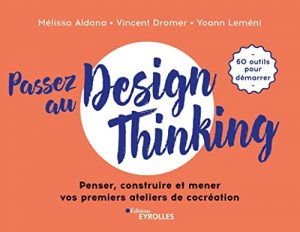Vous avez cherché un livre sur le design thinking cependant vous êtes en train de décider lequel choisir?
Ne vous inquiétez pas Les Livres a préparé pour toi un classement des livres meilleurs de tous les temps achetables online.
[acf field=”intro”]
Sommaire
- 1 🏆 Meilleurs livres sur le design thinking 2025: notre sélection
- 1.1 Design Thinking in the Digital Age
- 1.2 Concevoir des produits documentaires et livrables de veille avec le design thinking
- 1.3 Design Thinking: Le manuel d’innovation
- 1.4 LIFE DESIGN THINKING: Applying System Design Thinking to your Life!
- 1.5 Design Thinking: Revolutionize Your Approach to Problem-Solving
- 2 🥇Meilleuer livre sur le design thinking: l’incontournable
🏆 Meilleurs livres sur le design thinking 2025: notre sélection
Design Thinking in the Digital Age
- G., Rowe peter (Auteur)
"Design Thinking in the Digital Age" by Peter G. Rowe explores the application of design thinking principles in the context of the rapidly evolving digital landscape. Rowe argues that traditional design thinking methods need to be adapted and expanded in order to effectively address the challenges and opportunities present in the digital age. The book begins by providing an overview of design thinking and its core principles, such as user-centricity, iteration, and collaboration. Rowe highlights the need for designers to be well-versed in technology and digital tools in order to navigate the complex and dynamic digital world. The book then delves into specific strategies and case studies that illustrate how design thinking can be applied to various digital contexts. This includes areas such as user experience design, product development, service design, and digital transformation. Rowe also examines the influence of emerging technologies, such as artificial intelligence, virtual reality, and the Internet of Things, on design thinking. He explores how these technologies can be harnessed to enhance the design process and create innovative solutions for digital-age challenges. Throughout the book, Rowe emphasizes the importance of empathy and understanding the needs and desires of users in the digital realm. He argues that successful design in the digital age requires designers to constantly iterate, adapt, and learn from feedback in order to create engaging and meaningful experiences. "Design Thinking in the Digital Age" serves as a guide for designers, entrepreneurs, and business leaders looking to leverage design thinking principles in the digital landscape. It offers practical insights and strategies for creating user-centered digital solutions that are both functional and aesthetically pleasing.
Concevoir des produits documentaires et livrables de veille avec le design thinking
- Vaissaire-Agard, Clotilde (Auteur)
Le design thinking est une approche de conception qui permet de résoudre des problèmes de façon créative et innovante en mettant l'utilisateur au centre du processus. Dans le cadre de la veille, cette méthode peut être utilisée pour concevoir des produits documentaires et livrables qui répondent aux besoins spécifiques des utilisateurs. Pour commencer, il est important de bien comprendre les besoins des utilisateurs en matière de veille. Cela peut être fait en effectuant des entretiens avec les utilisateurs et en observant leur comportement lorsqu'ils utilisent des produits documentaires existants. Ensuite, il convient d'identifier les problèmes ou les défis que les utilisateurs rencontrent actuellement lors de la réalisation de leur veille. Ces problèmes peuvent être liés à la recherche d'information, à la gestion des sources, à la synthèse des données, etc. Une fois que les besoins et les problèmes des utilisateurs sont clairement identifiés, il est possible de commencer à générer des idées de produits documentaires et de livrables qui pourraient répondre à ces besoins. Le design thinking encourage la créativité et la prise de risque, donc il est important de ne pas se limiter à des idées traditionnelles. Il peut être utile de faire appel à des techniques de brainstorming et de cartographie des idées pour générer un maximum de concepts. Ensuite, les idées doivent être prototypées et testées avec les utilisateurs. Cela peut se faire de différentes manières, par exemple en créant des maquettes papier ou en développant des prototypes numériques. Les retours d'utilisateurs sont essentiels pour faire évoluer et améliorer les produits. Enfin, une fois que les produits documentaires et livrables ont été développés et testés, ils peuvent être mis en œuvre dans la pratique de la veille. Il est important de prévoir un suivi régulier pour évaluer leur efficacité et les ajuster si nécessaire. En utilisant le design thinking pour concevoir des produits documentaires et livrables de veille, il est possible de créer des solutions innovantes et adaptées aux besoins des utilisateurs. Cela permet de rendre la veille plus efficace et plus pertinente dans un environnement en constante évolution.
Design Thinking: Le manuel d’innovation
- Silva, Fabricio (Auteur)
Le manuel d'innovation "Design Thinking" de Silva, Fabricio, est un guide complet pour apprendre et appliquer le processus de Design Thinking. Ce livre offre une approche pratique et structurée pour développer des solutions innovantes aux problèmes complexes. Il explore les différentes étapes du processus de Design Thinking, en mettant l'accent sur l'empathie, la définition du problème, la génération d'idées, le prototypage et les tests. L'auteur présente également des méthodes et des outils spécifiques à chaque étape, ainsi que des exemples et des études de cas réels pour illustrer leur application pratique. Il aborde également des sujets tels que la collaboration en équipe, la communication et la mise en œuvre des solutions. En utilisant le Design Thinking comme méthode, le manuel encourage les lecteurs à adopter une approche centrée sur l'utilisateur et à prendre en compte les besoins, les émotions et les motivations des utilisateurs finaux lors de la conception de produits, de services et de solutions. L'approche holistique du Design Thinking proposée dans le manuel permet aux lecteurs d'appréhender les problèmes de manière créative et d'explorer de nouvelles voies pour l'innovation. En résumé, le manuel d'innovation "Design Thinking" de Silva, Fabricio est un guide pratique et complet pour développer des compétences en matière d'innovation à travers le processus de Design Thinking. Il est accessible aux débutants tout en offrant des idées et des outils utiles aux professionnels plus expérimentés.
LIFE DESIGN THINKING: Applying System Design Thinking to your Life!
- Mokhtari, Dr. Sam (Auteur)
"LIFE DESIGN THINKING: Applying System Design Thinking to your Life!" is a book written by Dr. Sam Mokhtari.
Design Thinking: Revolutionize Your Approach to Problem-Solving
- Vincent, B (Auteur)
"Design Thinking: Revolutionize Your Approach to Problem-Solving" by Vincent, B. is a book that explores the concepts and principles of design thinking and how it can be applied to problem-solving. The book begins by introducing the concept of design thinking and its three core principles: empathy, experimentation, and collaboration. It emphasizes the importance of understanding the needs and perspectives of users or customers and taking a human-centric approach to problem-solving. The author then delves into the five stages of the design thinking process: empathize, define, ideate, prototype, and test. Each stage is explained in detail, with examples and case studies provided to illustrate how design thinking has been successfully applied in various real-world scenarios. Throughout the book, Vincent, B. provides practical tips and techniques for applying design thinking in different contexts, whether it be in business, education, healthcare, or social innovation. The reader is encouraged to adopt a mindset of curiosity and experimentation, and to embrace failure as a learning opportunity. One unique aspect of the book is its emphasis on collaboration and interdisciplinary teamwork. Vincent, B. highlights the importance of bringing together individuals with diverse backgrounds and perspectives in order to foster creativity and generate innovative solutions. Overall, "Design Thinking: Revolutionize Your Approach to Problem-Solving" offers a comprehensive introduction to the principles and practices of design thinking. It is a valuable resource for individuals and organizations looking to transform their problem-solving approaches and drive innovation.
🥇Meilleuer livre sur le design thinking: l’incontournable
Choisissez le meilleur livre sur le design thinking peut être un peu plus compliqué que vous croyez. Pourtant, basé sur notre opinion, Design Thinking in the Digital au prix de 12,00 EUR résultats le meilleur livre présent sur le marché :

J’ai transformé ma passion pour les livres en un site Web, dans l’espoir d’aider les gens à trouver les meilleures lectures.










